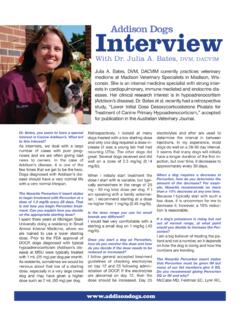Transcription of Lumpy Skin Disease (LSD) field manual - Home | Food and ...
1 A field manual for veterinariansmanualISSN 1810-111920 FAO animal PRODUCTION AND HEALTHL umpy skin Disease (LSD) is a viral Disease of cattle. Characterized by nodules on the skin , it is mostly transmitted by mosquitoes, by other hematophagous insects, and flies. The Disease has dramatic effects on rural livelihoods, which are often strongly dependent on cattle, as it slashes milk production and may lead to sterility in bulls and fertility problems in females. It damages hides, and causes death due to secondary bacterial infections. Effects at national level are also devastating as the presence of the Disease triggers strict trade restrictions.
2 Although traditionally limited to sub-Saharan Africa, LSD has slowly been invading new territories such as the Middle East and Turkey, and since 2015, most of the Balkan countries, the Caucasus and the Russian Federation, where the Disease continues to spread. The risk of an imminent incursion into neighbouring, still unaffected countries, is very the current situation, veterinary services from affected and at-risk countries in the Middle East and Europe are facing the Disease for first time. Official veterinarians, cattle farmers, and others along the value chain are therefore unfamiliar with LSD s clinical presentation, its transmission routes and the available prevention and control options.
3 This manual aims to fill these gaps by providing veterinary professionals and paraprofessionals with the information they need to promptly diagnose and react to an outbreak of LSD. Cattle farmers will also benefit from reading skin DISEASE20 FAOL umpy skin diseaseI7330EN/1 978-92-5-109776-29789251 097762 ISSN 1810-1119 Cover photographs left to right:Left: FAO/Eran : National Food Agency, : FAO/Attila animal PRODUCTION AND HEALTH manual20 FOOD AND AGRICULTURE ORGANIZATION OF THE UNITED NATIONSRome, 2017 Lumpy skin DISEASEA field manual for veterinariansAuthorsEeva TuppurainenIndependent consultantTsviatko AlexandrovBulgarian Food Safety Authority (BFSA)Daniel Beltr n-AlcrudoFAOThe designations employed and the presentation of material in this information product do not imply the expression of any opinion whatsoever on the part of the Food and Agriculture Organization of the United Nations (FAO)
4 Concerning the legal or development status of any country, territory, city or area or of its authorities, or concerning the delimitation of its frontiers or boundaries. The mention of specific companies or products of manufacturers, whether or not these have been patented, does not imply that these have been endorsed or recommended by FAO in preference to others of a similar nature that are not views expressed in this information product are those of the author(s) and do not necessarily reflect the views or policies of 978-92-5-109776-2 FAO, 2017 FAO encourages the use, reproduction and dissemination of material in this information product.
5 Except where otherwise indicated, material may be copied, downloaded and printed for private study, research and teaching purposes, or for use in non-commercial products or services, provided that appropriate acknowledgement of FAO as the source and copyright holder is given and that FAO s endorsement of users views, products or services is not implied in any requests for translation and adaptation rights, and for resale and other commercial use rights should be made via or addressed to information products are available on the FAO website ( ) and can be purchased through CitationTuppurainen, E.
6 , Alexandrov, T. & Beltr n-Alcrudo, D. 2017. Lumpy skin Disease field manual A manual for veterinarians. FAO animal Production and Health manual No. 20. Rome. Food and Agriculture Organization of the United Nations (FAO). 60 vAcronyms viiIntroduction 1 Epidemiology 3 Causative agent 3 Geographic distribution 3 Susceptible hosts 4 Transmission 5 Clinical signs
7 Of Lumpy skin Disease and postmortem findings 7 Differential diagnosis 15 Measures on the farm when Disease suspected 21 How to conduct an outbreak investigation 22 Sample collection 25 Preferred sample types 25 General rules 25 Transport of samples nationally and internationally 29 Dispatch and storage of samples during transport 29 Laboratory confirmation of suspected cases and available diagnostic tools 33 Virus detection 33 Detection of antibodies 34 Role of the national reference laboratory 34 International reference laboratories (contact points and information) 35 Control and prevention of Lumpy skin Disease 37 Prevention of Lumpy skin Disease 37 Currently available vaccines, selection of an effective vaccine, 37 adverse reactions and vaccination strategyCattle movement controls 40 Stamping-out policies and disposal of carcasses 40 Cleaning and disinfection of personnel.
8 Premises and the environment 42 Insect control on animals and in the environment 42 Biosecurity measures at holdings 43 Target audience for awareness campaigns 43 Surveillance programmes 43 References 45ivLIST OF FIGURES1 Countries that have reported LSD 42 Schematic illustration of the spread of LSDV 53 Some airborne LSDV vectors 64 South African Bont Ticks (Amblyomma hebraeum) feeding 55 Mild case of LSD showing characteristic skin lesions (full body) 86 Mild case of LSD showing characteristic skin lesions (neck)
9 87 Severely affected cow with multiple skin lesions 98 Severely affected cow with skin lesions covering the entire body, and enlarged lymph node 99 skin lesions in the perineum and genitalia 1010 Severe form of LSD with skin lesions in the head, neck, limbs and entire body 1011 Conjunctivitis and nodular skin lesions on the head 1112 Ulcerative lesions in the muzzle and lips 1113 Ulcerative skin lesion before scab formation 1214 Severe case of LSD with skin nodules covering the udder and teats 1215 Ulcerative lesion in the teat 1316 skin lesion with a scab attracting domestic flies 1317 skin lesions with scabs.
10 Ulcers and scars 1418 Internal LSD lesions 1419 Bovine Herpesvirus 2 1620 Pruriginous urticaria 1621 Pseudocowpox lesions on the teats 1722 Ringworm 1723 Demodicosis skin lesions 1824 Papular stomatitis 1825 Besnoitiosis 1926 Onchocerciasis lesions on the ventrum 1927 Clinical examination 2228 Collection of saliva for PCR testing during an outbreak in Bulgaria 2729 Scabs are excellent sample material. Scab coming off leaves a raw ulcer 2830 Collection of blood samples from the tail vein in vacutainer EDTA for PCR testing 2831 Labels used for international transfer of infectious substances 3132 Local reaction at vaccination site 3833 Post-vaccination superficial generalized skin lesions 3934 Post-vaccination superficial skin lesions in the udder 3935 Burial of carcasses 4136 Disinfection operations following an LSD outbreak 42vForewordLumpy skin Disease (LSD) was for long restricted to sub-Saharan Africa.


















